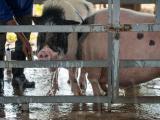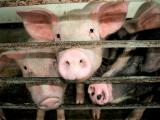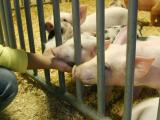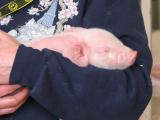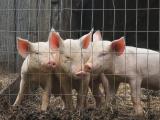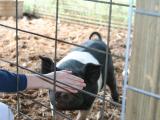Aug 31, 2012 (CIDRAP News) – Three people contracted H1N2 influenza infections, a strain very rarely seen in humans, after exposure to pigs at the Minnesota State Fair in the Twin Cities, the Minnesota Department of Health (MDH) announced this afternoon.
One of the three cases has been confirmed by the Centers for Disease Control and Prevention (CDC), and test results for the other two cases were pending, the MDH said in a press release. One of the patients was hospitalized, but all three have recovered or are recovering.
The MDH said the variant H1N2, or H1N2v, strain is different from the swine-origin H3N2v strain that has caused about 290 illness cases so far this year, mostly in people exposed to pigs at county and state fairs.
Two sick pigs at the State Fair swine exhibit were found to be infected with the same H1N2 virus earlier this week, and were isolated from contact with other pigs, the MDH said, adding that H1N2 infections are not considered unusual in pigs.
One of the three human cases has been confirmed in a teenage girl who was exhibiting pigs at the fair and became ill on Aug 26, according to the MDH. Another case occurred in an elementary-school-aged boy who got sick on Aug 27 after spending all day in the swine barn on Aug 24, and the third case involved a woman in her late 70s who became ill on Aug 26 after spending a long time in the swine barn and at the swine show in the fair Exhibit Hall on Aug 24.
Both the boy and the older woman had underlying health conditions and were treated with antiviral drugs, officials said. The woman was hospitalized but has been released. MDH spokesman Buddy Ferguson said he could give no further details on the severity of their illnesses.
The teenager was tested for influenza after she reported her illness to nursing staff at the fair. The other cases were reported to MDH by healthcare providers, the agency said. Healthcare providers have been asked to report cases of flu-like illness in people who have had contact with swine, and swine exhibitors have been asked to report any flu-like symptoms they experience.
"For the past two weeks, we have been looking very hard for cases of influenza in people who have been exposed to swine," Richard Danila, deputy state epidemiologist, said in the press release. "We have also worked closely with our veterinary colleagues to remain informed about potential infections in swine at the Fair. It is because of this careful surveillance that these cases have come to our attention."
The increased surveillance has been prompted by the concern about H3N2v. Three infections with that virus have been identified recently in Minnesota, all of them linked to a live animal market.
MDH officials said they do not expect to change their current recommendation that people at high risk for severe flu should avoid contact with pigs at exhibitions, live markets, and other venues. Those at thigh risk include children younger than 5 years, pregnant women, people over age 65, and those with chronic medical conditions.
Human H1N2 infections have been reported rarely, but one such case was reported in a Minnesota child in December 2011. The CDC said at the time that a similar case had been reported in Michigan in 2007. Both of those patients recovered.
In earlier reports, back in 2002 the CDC reported that a total of 11 human H1N2 cases were reported in three states in 2001. Nine of these were in Wisconsin, and the other two were in Nevada and Texas, the CDC said in an April 2002 article in Morbidity and Mortality Weekly Report (MMWR).
See also:
Aug 31 MDH press release
Dec 9, 2011, CIDRAP News story covering previous Minnesota H1N2 case
April 2002 MMWR report noting H1N2 cases in 2001
CDC table on recent variant influenza cases in humans
